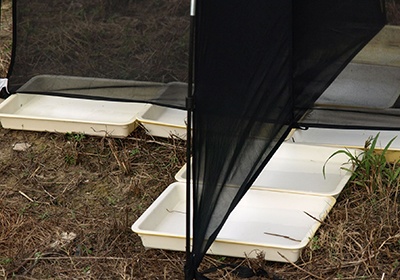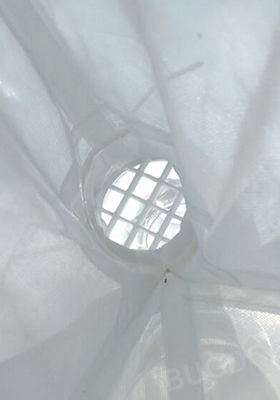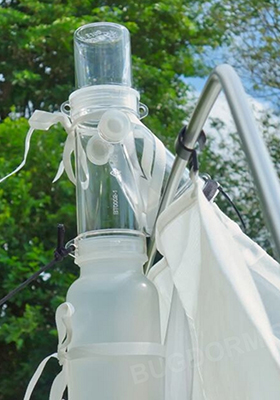Townes-style Malaise trap for standardized insect sampling
The BugDorm traditional Townes-style Malaise trap is a modular flight interception trap that requires external supports (trees, posts, or our installation kit) for standardized, bait-free sampling. A central mesh panel guides flying insects upward into the collection bottle, enabling long-term biodiversity and phenology surveys.
Field Application: The North American Insect Abundance Network (NAIN) employs standardized BugDorm Townes-style Malaise traps at monitoring sites across North America to study seasonal insect biomass and diversity trends. Coordinated sampling protocols ensure consistent trap orientation, exposure, and data comparability among research partners.
Detailed Description
The intercept panel measures W165 × H110 cm and is constructed from black polyester no-see-um mesh (96 × 26 per square inch) to retain minute taxa like parasitic Hymenoptera.
For window trap (FIT) use, position trays or ground cloths with preservative beneath the panel to collect taxa that drop after impact (e.g., Coleoptera). The collection head is molded from solid polycarbonate for impact resistance, UV stability, and clarity. Ventilation ports (closed by default) allow optional airflow; some studies report increased capture when airflow is enhanced. A removable moth excluder (1 × 1 cm grid) limits entry of large Lepidoptera to reduce wing-scale contamination.
Window Trap Setup
 Window Trap Setup
Window Trap Setup
Removable Moth Excluder
 Removable Moth Excluder
Removable Moth Excluder
Proper Collection Head Connection
 Proper Collection Head Connection
Proper Collection Head Connection
ŌÜĀ’ĖÅ Head junction: Tie the ribbons firmly where the fabric funnel meets the collection head and verify both zip-ties are intact. Keep the roof line under gentle tension to prevent detachment—do not overstretch.
Functional Advantages
- Standardized intercept: Townes-style geometry for comparable, bait-free sampling across sites and seasons.
- Fine mesh retention: 96 × 26 mesh helps retain minute Hymenoptera and other small insects.
- Serviceability: 500 ml bottle unscrews quickly for sample changes and labeling in the field.
- Optional FIT mode: Works as a window trap by placing trays/ground cloths with preservative beneath panel.
- Durable head: Polycarbonate head with optional airflow ports and removable moth excluder.
Authenticity: Our Traditional Malaise Trap is a field-proven design used in large-scale research worldwide and cited in hundreds of peer-reviewed studies. Look-alike copies may exist, but only the BugDorm Traditional Malaise Trap adheres to strict material, mesh, and dimensional specifications, ensuring repeatable results and cross-site comparability.
Field Notes
- Placement: Align panel perpendicular to expected insect flight paths (trails, edges, stream corridors).
- Stability: Requires a minimum of two guy ropes; add more in wind or exposed sites.
- Ventilation ports: Opening ports may improve airflow but can admit rain and accelerate evaporation.
- Sun and wind: Note sun position and wind direction. Provide shade in hot/dry conditions to reduce preservative loss.
- Servicing: Empty/replace bottles on a fixed schedule; re-tension lines after strong wind or a heavy catch.
- Maintenance: Clean mesh panels periodically to maintain airflow and capture efficiency.
- Alternatives: Need freestanding deployment or canopy work? Consider the SLAM trap or ez-Malaise trap.
Field Checklist
Before You Leave the Site
- Site selected (trail/edge/stream); record compass bearing
- Orient panel perpendicular to expected insect flight paths
- Ground hazards cleared beneath intercept panel
- Stakes seated; sufficient guy ropes secured for windy conditions
- Ridge line tensioned gently; avoid overstretching fabric
- Head junction ribbons tied; both zip-ties intact
- Moth excluder installed if large Lepidoptera are abundant
- Collection bottle fitted tightly; pre-labeled (trap ID/site/date)
- Preservative added (per protocol) and volume checked
- Ventilation ports left closed by default (note if opened)
- (Optional) FIT trays or ground cloths placed with preservative
- GPS, habitat notes, sun position, wind direction recorded
- Photos taken (overall setup and surroundings)
- Service interval scheduled (e.g., every 3–7 days; local conditions)
- After wind/heavy catch: re-tension guy ropes and roof line
- Mesh cleaned if clogged with debris/scale
- Spares in kit: bottles, caps, preservative, zip-ties, ribbons
- Before leaving: labels/caps secure; lines and stakes checked
Ōä╣’ĖÄ Disclaimer: Field Notes & Checklist provide practical guidance and examples. Actual procedures should be adapted to site conditions, study objectives, and institutional protocols. Users are responsible for safe deployment and compliance with local regulations.
Pack Contents
- 1 × Fabric Trap Body
- 1 × Collection Head (pre-installed)
- 1 × Collection Bottle (pre-installed)
alternative option
Nalgene™ 2105-0016 wide-mouth bottles (53 mm closure; unavailable from this site) are compatible with the supplied bottle.
Replacement parts are listed under the Parts tab. Tent pegs, guy ropes, and support poles are not included.
Recent Literature Related to This Product Line (click to search more)